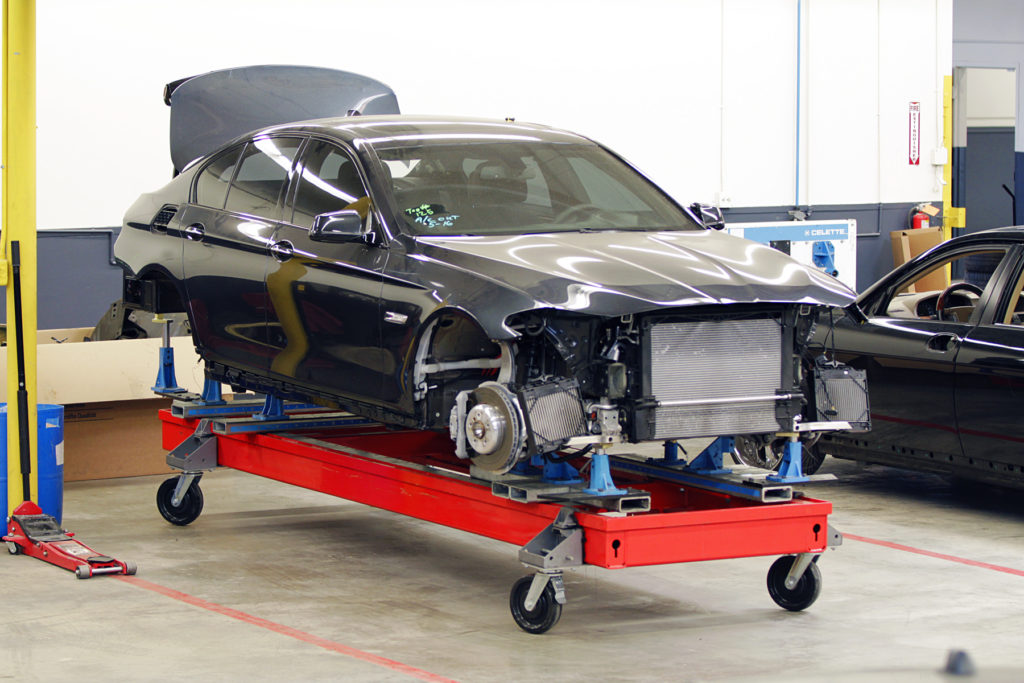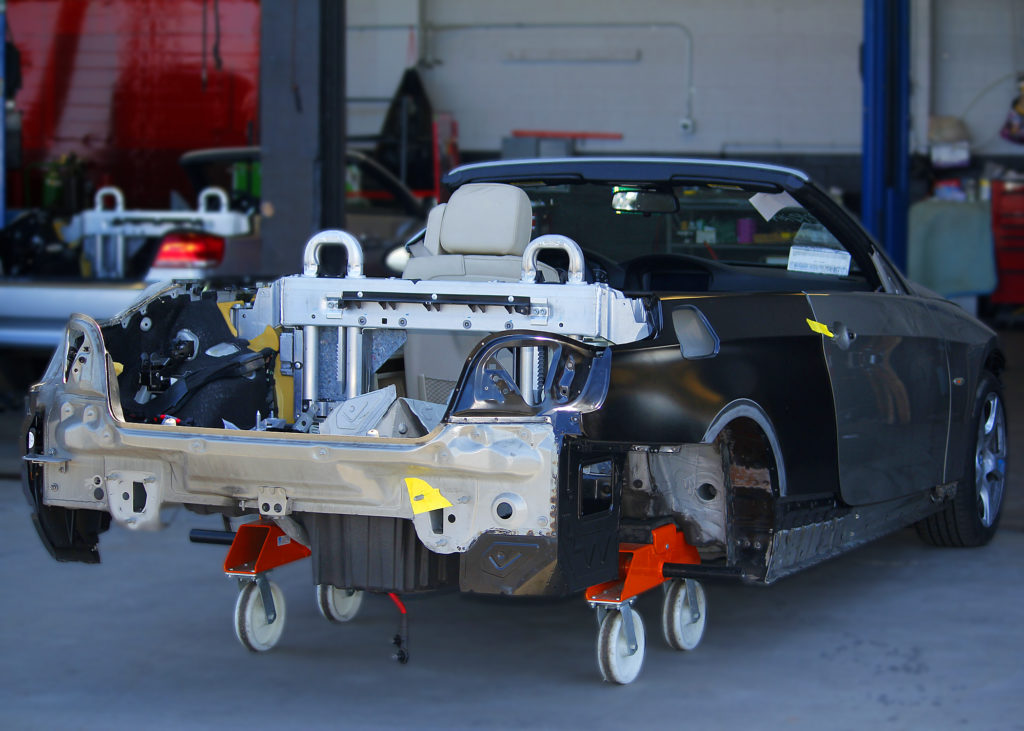
Repairer: GEICO disregards ‘workmanlike’ Calif. rule on BMW; CDI says it can’t help
By onBusiness Practices | International | Market Trends | Repair Operations | Technology
After months, the California Department of Insurance has refused to rule on GEICO’s refusal to pay for the additional cooling systems on a customer’s turbocharged 2017 BMW 530i, a Southern California collision repairer said.
The department concluded it was a “difference of opinion,” despite the extensive documentation a repair professional working for the shop provided from CCC, BMW and even California law.
CDI insurance compliance officer Abraham Rivero wrote Feb. 12 that the agency did a “comprehensive review” of all documents submitted in the dispute involving a customer at the shop.
“The issues involved with your complaint indicate that there is a difference of opinion between you and the insurance company as to the reasonable cost to repair your customer’s vehicle,” he wrote to the repairer, who asked to be identified only with his last name, Martinez. “As the Department does not have the regulatory authority to decide this particular issue and render a binding decision as to the reasonable repair cost, after reviewing the information provided, we conclude that we are unable to assist you further with this matter.”
Martinez on Feb. 14 told the agency his customer would be out-of-pocket $1,300 and asked about the appeals process.
GEICO did not respond to emails seeking comment.
GEICO initially paid for all three cooling systems — though it initially alleged at least two of them should receive a body rate, triggering Martinez’s complaint to the CDI last year over his customer going $868.31 out-of-pocket.
But then GEICO Assistant Vice President of Claims J. Lee Meeler Jr. in a response to the complaint claimed his company shouldn’t have paid for anything besides the main radiator — and demanded nearly $500 back from the shop/customer.
Meeler on Oct. 4, 2018, told Martinez that GEICO did pay 3.5 hours mechanical labor for the condensor, which in the CCC estimating includes the inner radiator, outer radiator and condensor itself.
But it also “overpaid the claim by 7 hours body rate and 0.6 mechanical rate,” Meeler wrote.
“On line 85 and 86 of Supplement 2, you will see that we paid 3.5 hours body rate on each line to R&I inner and outer radiator. We also paid you for the included operaion to bleed the cooling system on line 95 of Supplement 2 at 0.6 mechanical rate.”
Meeler demanded $484 back from Martinez’s shop.
Additional radiator charges existed because the engine of the BMW had multiple cooling systems — there were two other radiators not captured in the stock CCC time, according to Martinez. The additional bleed time was related to the system taking more effort to service than the base CCC time, he said.
MOTOR Collision Estimating Data is based on the base model vehicle configuration, standard or regular production options, and/or standard replacement operations. “Add if required” operations are for extra procedures necessitated by optional factory equipment or certain collision scenarios that may be encountered. “Add if required” operations should be added to the estimate whenever applicable after an “on the spot” inspection of vehicle damage and/or vehicle options.
“I am the expert not you guys,” Martinez wrote to Meeler on Oct. 16, 2018, carbon-copying the California Department of Insurance. “This car has a low circuit, a high circuit and turbo coolers. The database does not account for the turbo units nor the high circuit. I have included the very extensive procedures for filling, leak testing and removal of the high circuit system which based on the MOTOR Guide, MUST be accounted for as manual entries and the ones in the database are clearly listed as Mechanical components. “
A series of BMW repair procedures collected by Martinez verify the scope of the operation. BMW in a response also didn’t dispute Martinez’ assertion to the OEM that the car “has an auxiliary system and a main system plus a cooling unit for the turbo system.”
Martinez noted that as the collision repairer, he had to follow California 16 CCR 3365 and deliver “workmanlike” repairs “performed in accordance with OEM service specifications or nationally distributed and periodically updated service specifications that are generally accepted by the autobody repair industry.”
It says the repairer MUST repair the vehicle the way the OEM Manufacturer advises. You clearly deviated from what the manufacturer says. Your appraiser deliberately short paid.
Insurers are bound to the same standard, under 10 CCR 2695.8(f), as Martinez pointed out. That regulation states:
The estimate prepared by or for the insurer shall be of an amount that will allow for repairs to be made in accordance with accepted trade standards for good and workmanlike automotive repairs by an “auto body repair shop” as defined in section 9889.51 of the Business and Professions Code, and in accordance with the standards of automotive repair required of auto body repair shops as described in the Business and Professions Code and associated regulations, including, but not limited to, Section 3365 of Title 16 of the California Code of Regulations.
16 CCR 3365 says body shops must follow OEM procedures:
(a) Repair procedures including but not limited to the sectioning of component parts, shall be performed in accordance with OEM service specifications or nationally distributed and periodically updated service specifications that are generally accepted by the autobody repair industry
(b) All corrosion protection shall be applied in accordance with manufacturers’ specifications or nationally distributed and periodically updated service specifications that are generally accepted by the autobody repair industry.
“You too must abide by that definition of ‘workmanlike manner’,” Martinez wrote. “(W)e also have 2 different estimates. The one that (the shop) wrote to properly repair the car, and the one your team wrote to ‘settle’ the loss. …
“To close, this is not a difference in opinion, This is clearly Geico’s way of not paying. The repair bill prepared by (the shop) fullfills repairing the vehicle in ‘workmanlike’ manner. Geico’s does not.”
Noting that the CDI demanded he respond to Martinez, Meeler in a Nov. 1, 2018, letter basically repeated much of his Oct. 20, 2018, letter, except he called bleeding a radiator part of a radiator R&I or R&R, citing a CCC inquiry.
Which it would be on a base model — but there’s two other radiators to handle that GEICO was refusing to pay anything for, and the operations took longer when you accounted for BMW’s instructions according to Martinez. He provided his own CCC inquiry noting “detailed instructions” from BMW “on bleeding, filling, leak testing on the high temperature and the low temperature circuit of the cooling system” but a refusal to pay from GEICO:
I have explained this fact to the insurance company and they … keep saying that per the p page it is “included”. I tried explaining that your p page is a guide and that anything beyond the scope of a base model vehicle needs to have additional time accounted for on the spot. Please reply with a detailed clarification as there is no way that the time in your database to rr the radiators can include the time to leak test, fill and purge. On top of this issue noted above. This car also has water to air coolers for the turbocharging system that are not accounted for on your database. A manual entry was generated and the insurer refuses to pay anything out of the scope due to it not being in your database.
CCC replied that at times you would have to adjust times based on the vehicle before you:
• According to the “Guide To Estimating: RADIATOR”, “Drain, Check and Refill Fluids” and “Purge Air From System” is listed as “Included.”
• During the process of “Refill Fluids” and “Purge Air from System” the technician should “Visually Check” for leaks and “Cooling System Concerns.”
• Pressure Testing for Diagnosis of Cooling system is Not Included.
• Cooling System leak repair is Not Included.
• MOTOR recommends following OEM service repair information for Cooling System Leak Repair and mutually agreed upon before finalizing any repair cost estimate.
CCC’s P-pages also clearly state that the estimating services’ time apply to the base model:
MOTOR Collision Estimating Data is based on the base model vehicle configuration, standard or regular production options, and/or standard replacement operations. “Add if required” operations are for extra procedures necessitated by optional factory equipment or certain collision scenarios that may be encountered. “Add if required” operations should be added to the estimate whenever applicable after an “on the spot” inspection of vehicle damage and/or vehicle options.
California’s 10 CCR 2695.8(f), doesn’t just compel insurers to produce a “workmanlike” estimate, it also holds them to the processes of their selected estimating system:
“An insurer shall not prepare an estimate that deviates from the standards, costs, and/or guidelines provided by the third-party automobile collision repair estimating software used by the insurer to prepare the estimate, if such deviation would result in an estimate that would not allow for repairs to be made in accordance with accepted trade standards for good and workmanlike automotive repairs by an auto body repair shop, as described in this subdivision,” the regulation states.
If the claimant’s estimate is still higher, the carrier must pay the difference, give the consumer “that will make the repairs for the amount of the insurer’s written estimate” or “reasonably adjust” the estimate based upon the repair shop’s estimate.
“The adjusted estimate shall identify the specific adjustment made to each item and the cost associated with each adjustment made to the claimant’s shop’s estimate,” the regulation states.
GEICO didn’t bother to do any of that, according to Martinez.
“Geico never presented an adjusted estimate with factual information to refute our position,” he wrote to the CDI Feb. 14.
Martinez provided the department with what appeared to be an ironclad case packed with evidence from third-party sources and California regulatory law. Yet the California Department of Insurance still passed it off as a difference of opinion. That’s a tough break for consumers who have vehicles which go beyond the base model times in estimating systems — shops might have no choice but to charge them for the time.
“We the taxpayers have entrusted the Department to protect us from these actions and the Department is going to simply let Geico get away with this?” Martinez wrote Feb. 14. “I’m sure we are not the only ones sending in complaints about Geico. Please advise the course of action within the department to appeal this and have this looked at further by collision experts. The obvious was not considered. YOUR regulations stipulate that the insurance carriers MUST effectuate and settle claims using the manufacturers repair data or nationally distributed data. Geico skirted around that by not following the BMW instructions which were necessary to repair this vehicle correctly. … The department ignored the letter from the BMW Collision program director who is the factory BMW representative (not a 3rd party) which clearly outlined that if the repair instructions are not followed, the cooling unit can be damaged. How much more obvious can it be that this is NOT a difference of opinion?”
Martinez also noted that Rivero encouraged him to “consider contacting any trade/professional organizations to which your shop may belong for information regarding legislative reforms it may be seeking on behalf of the collision repair industry”
“Why would I have to do that in this case?” he asked, and pointed to 10 CCR 2695.8(f). “The legislation already exists.”
Images:
California Insurance Commissioner Ricardo Lara is shown. (Provided by California Department of Insurance)
A body shop. (Jhomayra Camacho Photography and Elle Oh Elle)
The GEICO mascot appears in the Circle City Classic Parade in Indianapolis, Ind., on Sept. 22, 2018. (Roberto Galan/iStock)



